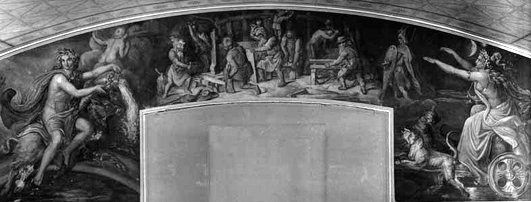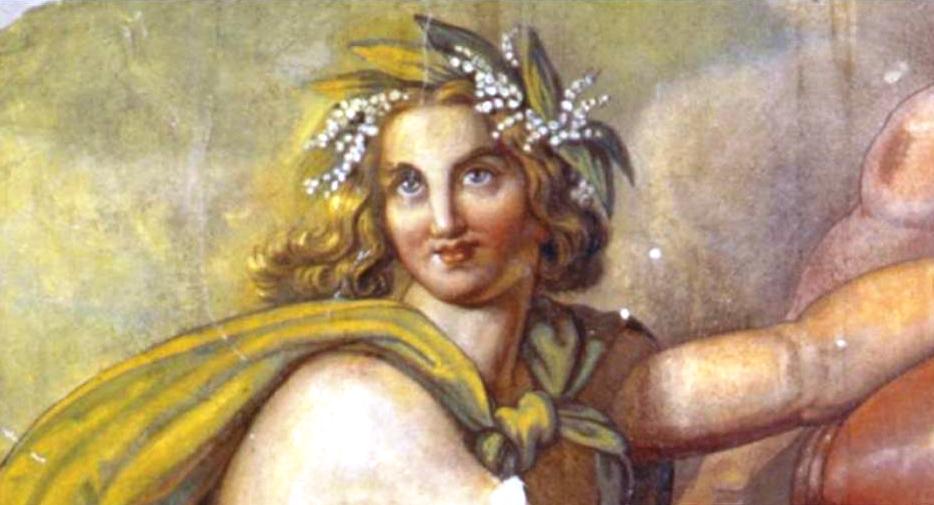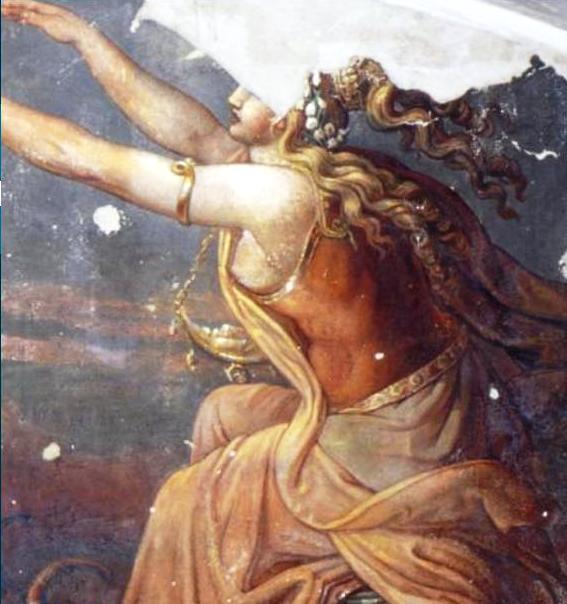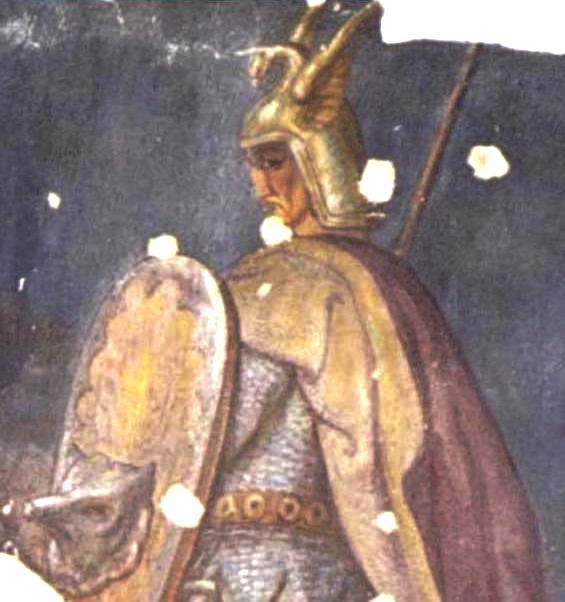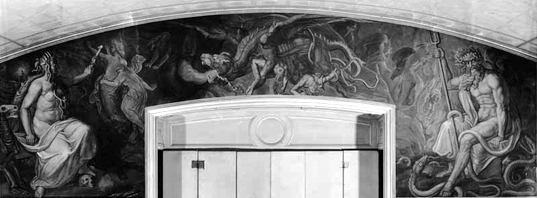Gustav Heidenreich,
Gustav Richter and Robert Müller
Artists of
Aus dem Sagenkreis der Edda
A Fresco-Cycle
in the
Neues Museum, Berlin

Neues Museum After Restoration
[HOME]
[POPULAR RETELLINGS]
|
The Neues Museum at Berlin opened in 1855 with displays of art and archeology at the heart of the so-called Museum Island, a complex at the center of the city, which the Prussian king Friedrich Wilhelm IV conceived as a public sanctuary of culture and learning in the 19th century. Painters were commissioned to execute a fresco-cycle from the stories of the Edda on the walls of the northern salon. Gustav Heidenreich was a historical painter, born in Berlin in 1819. He first studied under A. F. Konig in Breslau, and then under Wilhelm Wach in his native city, where he died in 1855, the same year the Neues Museum opened. Among his best work are his paintings in the Neues Museum— 'Hertha and Odin,' 'The Game of the Water-Witches,' 'The Battle of the Giants,' etc; as well as the classical frieze in the saloon of Greek Antiquities in the Altes Museum. Gustav Richter (1823-1884) studied at the Academy of Art in Berlin and was also educated by the French painter Léon Cogniet. From 1847 to 1849 he lived in Rome. Back in Germany he produced murals for the Neues Museum in Berlin. He also worked for king Maximilian II of Bavaria, king Friedrich Wilhelm IV, emperor Wilhelm I and Czar Alexander II. In 1930, the last of the Museum Island buildings, the current Pergamon Museum, finally opened. Then nine years later the whole complex was shut down with the onset of the second world war. The Neues Museum suffered much from Allied bombings in 1943 and 1945. Art that was too large to be moved out for safekeeping was destroyed.
For decades afterward the museum lay in shambles, exposed to the elements, neglected by the former Communist East Berlin government. Renovation began in 1986, the Neues Museum reopened in 2009 at a cost of $255 million.
|
| |||||||||||||
 |
||||||||||||||
| "From the Edda Saga-Cycle" | ||||||||||||||
|
Excerpt from Northern Germany: A
Handbook for Travellers (1886): The Ground Floor of The New Museum, which contains the collection of Northern Antiquities, the Ethnographical Collection (soon to be moved), and the Greek Court, on the right, and the Egyptian Museum on the left. The northern Antiquities, arranged in twelve cabinets and along the walls, consist of various kinds of weapons, household utensils, cinerary urns, gold and silver trinkets, &c, provided with the names of the places where they were found. Most of them were found in tumuli, and belong to various periods, ranging from the flint to the bronze and the Roman. The stereochromatic Mural paintings by Bellerman*, Mueller, Heidenreich, and Richter, illustrate the mythology of the North. [*Ferdinand Bellerman's paintings at the Neues Museum include "Giant's Grave and Sacrificial Stone."] On the West Wall, beginning opposite the entrance: 1st window: Hertha, the Ceres, and Odin, the Jupiter of the North; above them day and night. 2nd window: Baldur, the northern Apollo, and Hulda, the goddess of domestic life. 3rd window: Freyr, god of spring, and Freya, his sister, goddess of love; above them, dwarf ship-builders. 4th window: Odur and Freya on the battle-field, marking with blood the dead who are worthy of Valhalla (paradise of the heroes); in the centre Valkyries conducting the dead to Valhalla; right, Tyr, god of war. — Above the door: Odin, the universal father, left, the Valhalla, right, Helhcim, the abode of those who have died a natural death. — East Wall: wicked deities. By the first window left, Hel; right, Loki; by the 2nd window Nornas (fates); by the 3rd window watersprites, the griffin, and contest of the giants with the dragon; by the 4th window Titania and elves; Thor, god of thunder, in a chariot drawn by mountain-goats. |
||||||||||||||
|
The scope of the work can be reconstructed
from a description of the fresco cycle in
Die Deutsche Götterlehre und ihre Verwertung in Kunst und Dichtung, Volume 1: The principal deities of the Germanic world were depicted in their particular spheres of activity by the painters Heidenreich, Müller and Richter in the Neues Museum in Berlin, in the gallery known as "The Hall of Northern Antiquities" (Vaterländischen Saal).
As one steps into the hall, "Nerthus" forms the first image at the bottom on the right wall. As described by Tacitus, the Germanic goddess of the earth rides on a wheeled cart, drawn by two whites cows. Her blond hair is adorned with a wreath. With uplifted hands, she scatters flowers on her journey over the earth. A reddish brown robe exposes her feet and forearms.
In the top center field, one sees "Night," a
female figure in dark green robe and blue cloak on her
dark gray steed Hrimfaxi. Dew falls from its nostrils
and falls on the earth. Behind her is a larger, dark
wolf, Hati,
the greedy. To the right, we see "Day," a naked
youth riding on the yellow stallion Skinfaxi,
whose bright mane illuminates the earth and air.
A flowing red cloth wraps the youth, whose face
and hands are turned upwards.
The steed carries a sunflower in its mouth.
In the background, we see the persecutor of
light, the wolf Sköll.
To the left, with a halo flickering behind his head, sits Odin, the king of the gods, on his throne in Asgard. He is not depicted as an old man, but in the full vigor of manhood. His hair is strawberry blonde. His long beard flows over white robes. A winged helmet covers his head. In his left hand, he holds the spear Gungnir. His right hand rests on his hips. Two ravens, Hugin and Munin, fly to whisper their latest news into his ear. At his feet cower the two wolves Geri and Freki, one of which looks up at him expectantly, perhaps begging for a bite of meat. Odin himself needs no food. He only drinks blood-red wine.
|
||||||||||||||
|
BALDUR'S DEATH THROUGH LOKI'S TREACHERY by Gustav Richter  Photo from 1928  Photo from 2002 Prior to Restoration |
||||||||||||||
 Fragment After Restoration |
||||||||||||||
|
The next mural is divided into three parts.
Baldur, the good and beautiful god of spring. at the
entrance to a columned Valhalla.
A cloth robe extends from his left arm to his right
leg.
The rest of his body is uncovered. He is radiant,
soft and delicate, almost feminine.
Mild radiance illuminates his face.
In his left hand, he holds a harp, his right is
stretched sideways and down.

In the middle, we see Baldur's blind brother
Hödur, in a sitting position, drawing his bow.
Behind him, Loki reaches toward the mistletoe
arrow.
Good natured, Hödur almost looks indifferent,
but from Loki's face shines diabolical malice
and glee, as he bends down toward Hödur.
A cloth covers Hödur's loins. Loki, dressed in a
short tunic, has reddish hair. Horns and bat
wings adorn his head.
Behind this group, Nanna, Baldr's wife,
anxiously stretches both hands toward Loki.
A yellow cloth covers only part of her tender
body.
  In the lower right is an image of Frigg-Holda, the patroness of weaving and of new and unborn children. In her left hand, she holds the distaff high, with the right she pulls the thread sideways. At her feet small, naked children play in a fountain with apples and other fruits. The goddess' upper body is uncovered, a green robe falls over her legs. A wreath adorns her head. She is depicted seated, with long blond hair cascading down her back.
The third mural shows the God
Freyr on his boar Gullinbursti, whose golden bristles
brighten the night the same as day.
His head is crowned, a green- yellow robe flutters
around the nude figure.
A bird
flies behind him.
Behind him, a naked little boy floats on clouds, his cheeks
blow out the wind.
Freyr himself pours bright bubbles from a garlanded
pitcher.
The fourth mural shows two figures on horseback in the foreground, one of which seems to be Freyja. With their upraised hands, both splatter blood on the field of battle, to crown the heroes, two of which lie prostrate beneath them. In the top middle, one sees five Valkyries. Two carry a hero to Valhalla, holding him by the legs and arms. One hero has his shield. The fifth Valkyrie, hovering in the top center, flies ahead harp in hand, to sing of his heroic deeds. All are without wings, but fluttering robes surround the figures. On the right, we see the god of battle Tyr in red robe, equipped with armor, sword belt and winged helmet. His curly hair and his beard are red. With his left hand, he stretches his sword high before him, because his right arm is mutilated. The Fenris wolf has bitten off his hand. The stump is wrapped in towels. But the wolf whose paws are tied with magic fetters, lay at his feet and snaps greedily at the legs of the god who is preparing for the onward march.
Having thus traced the painting on the right wall of the room, we turn to the backwall. Valhalla is on the left. Odin is perched on the high seat, his wife Frigg to his right. She wears a white robe with a blue sash. A purple cloak is cast over his shoulders. In his right hand he holds a scepter, and his head is crowned. With his left hand he holds out a drinking horn, in which a half-naked Valkyrie pours him wine. She wears a swan dress. We see the wings on the back, hang over the sides; the head, neck and beak rest on her front chest. Her head is crowned. Before Odin and Frigg, we see einherjes feasting and drinking, some sitting, some standing. Valkyries fill their drinking horns with mead. Their helmets are shaped differently and decorated. Two einherjes in the background appear newly arrived. On the right, a female figure, probably Skuld or Idun, stands in robe and breastplate. Golden apples hang on the branches of the tree.
Located just above the entrance door
is a bust of
All-father with grey-white beard and hair.
His robe is
white.
He stretches out his arms to both sides, holding
a tablet in
each hand.
On his left hand is the form of a male, the other is
that of
a female.  Modgud  Baldur and Nanna Arrive in Hel  Ghouls lurk in the dark. Two female ghouls with a dog between them.  Thokk Further to the left, in the foreground, sits a second female figure also in dark robe. She is the giantess Thökk, who alone of all beings did not want to cry for Baldur. That all weep for Balder without exception was the condition under which Hel had promised the gods messenger Hermod, that Balder would return again to the world of light. Now Baldur was obliged to remain in the realm of shadows. Behind Balder and Nanna hovers a second pair, a female figure carrying a child in her hands. Behind her, we see a female figure, her arms crossed over her chest, and behind her two warriors, whom, it seems, died the straw death.
 Photo from 2002 Prior to Restoration  Loki 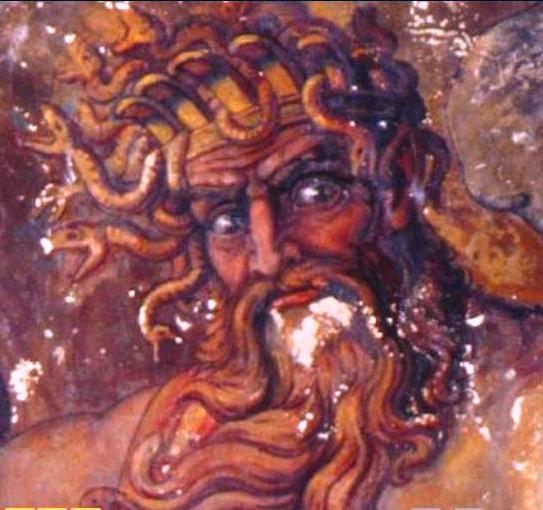
Having thus seen it in the last painting, the
entrance to the realm of Hel meets us in the first
picture on the left wall. In the window, Helheim
itself spreads out before our eyes.
On the far left sits the terrible Hel's
naked upper
body, which is dark in color on one side, and light on the
other.
Her hair, made of snakes, curls down over her
face.
In her left hand, she holds a human bone
a scepter aloft
toward the new comers. Her
left foot
rests on a human skull.
To her left is the black hell-hound Garm. In the right of the window, we see Loki, almost naked, draped in a red robe with a red beard and shaggy red hair. The Midgard Serpent winds around him.
On the
left of the window, we now see Urd, Norn of the
past, sitting on Urd's brunn, in a blue robe, her right
breast exposed.
In her left hand, she holds a shield upright before her,
which leads to the pen in her right hand, which records
deeds.
In the fountain in front of her, two
silver-white swans make their circles . |
||||||||||||||
The left side of the next window shows us a picture of mermaids (water nixies) playing in and around water. We see four female figures with bare torsos. A mermaid swims in the foreground, her back toward us. She has both hands stretched upward, as if to pluck fruit from a tree overhanging the water. Her head is like that of the other three, garlanded and adorned with a string of pearls. All of them have blonde hair. A second mermaid sits on the banks. She holds a lyre in one hand, the other is placed on her right cheek. Behind her, sitting right on the edge of the pond, are the other two. In the middle we see a griffon atop a flashing treasure pile. Furious, he spreads his wings and has opened its curved beak. He looks at the two giants. These two giants are already battling — as we see on the right — with a terrible, great dragon that opens its wide- gaping jaws against the foremost giant who holds a piece of rock with hands up there to smash into the monster's gaping mouth. The second giant stands in the background, swinging a stone. Both are nearly naked. The dragon is yellow-brown, with a blood-red mouth and tongue. He has black wings on his back.
On the last window of the hall, we see left Titania, Queen of the Elves. She floats carried over the water by two elves in flowing robes; one of which holds a lyre. The clothes of the elves are blue and yellow. A purple robe wraps Titania, and a diadem adorns her head. With herleft hand, she holds a mighty garland high in front of them. From her right, she throws a flower. Beside her shines the last quarter of the waning moon. The midfield shows an elf-ring. Seven virginal figures dance, almost completely naked, swaying in graceful positions and reaching out with their hands. A thin mist surrounds them in the meadow below. The final image shows the thunder god Thor standing in his chariot. His two goats stand on white clouds. The one on the left is light gray, the other is brown. In his right hand, Thor, almost unclothed, swings his hammer, emitting lightning in zigzag bolts. He has put on the belt of strength. His hair and beard are blond. He has his face turned slightly to the left, as if he sees an enemy there, perhaps a mountain giant, he intends to smash. |

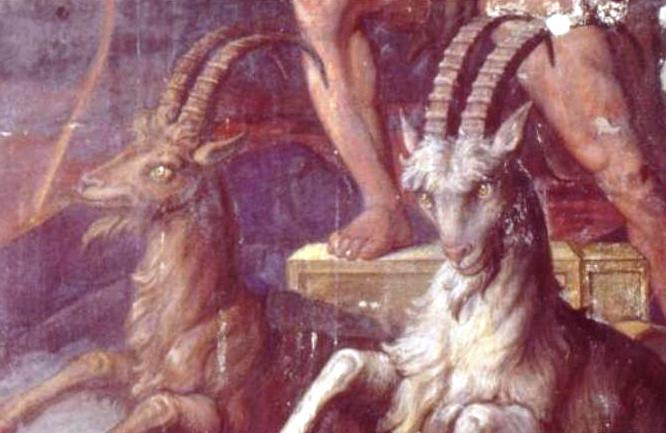
[HOME]
[POPULAR RETELLINGS]





